Palaeoenvironmental reconstruction for the Permian (lower Gondwana) succession of the Godavari Valley Coalfield in southern India based on a combined palynofacies, carbon isotope, and biomarker study
Neha Aggarwal, Runcie Paul Mathews, Arif Husain Ansari,Biswajeet Thakur, Shailesh Agrawal
Birbal Sahni Institute of Palaeosciences, 53 University Road, Lucknow 226007, India
Abstract The study presents integrated palynofacies, organic carbon isotope, and biomarker data to reconstruct palaeoenviromental setting for the Permian sediments(borehole MGK-6)of the Kachinapalli block of the Godavari Valley Coalfield,southern India.The palynofacies data reveal three distinct palynofacies(A-C)as follows.Palynofacies A is dominated by abundant arborescent vegetation(glossopterids and conifers)along with structured organic matter,suggesting freshwater forest swamps in proximal settings.Palynofacies B is dominated by abundant degraded organic matter and amorphous organic matter,suggesting lakeshore/flooded palaeomires in slightly dismal settings. It has a high water level in the hinterland, which enables bacterial degradation of organic matter and establishes low-oxygenation conditions within the water column. These conditions would have provided grounds for the accumulation of either degraded or amorphous organic matter. Palynofacies C is dominated by the abundance of charcoal/opaque phytoclasts, indicating prolonged transportation or postdepositional alteration, suggesting a highly-oxidizing condition in distal settings. The bulk organic δ13C range(−25.1‰to −20.9‰)in the borehole MGK-6 is in close agreement with the global Permian records.This study also shows a weak but statistically significant correlation with the major forms of palynofacies A and C. The interlinked behaviour of bulk organic δ13C and palynofacies suggests that the changes in palaeobiogeography/palaeodepositional settings were most likely driven by the change in mean annual precipitation.The biomarker study shows the presence of n-alkane from C15 to C31 with unimodal and bimodal distribution patterns,revealing the source materials as vascular plants and microbially-altered organic matter. The combined palynofacies,organic carbon isotope, and biomarker data provide vital clue to salient findings for the development of environmental conditions of Godavari Valley Coalfield during lower Gondwana sedimentation.
Keywords Artinskian,Guadalupian,Depositional environment,Carbon isotope,Biomarker,Godavari valley coalfield
1.Introduction
Across India,Gondwana deposits are exposed along four main river valley basins, i.e., the Damodar, Son-Mahanadi, Wardha-Godavari, and Satpura. They are fluviatile,glacigenic,lacustrine, and non-marine sediments containing distinctive plant and animal fossils(Medlicott and Blandford, 1879; Ghosh et al., 1994;Mukhopadhyay et al.,2010;Aggarwal et al.,2019).The palynostratigraphy of the Godavari Valley Coalfield has been intensively studied(Srivastava and Jha,1996;Jha and Aggarwal, 2012; Aggarwal and Jha, 2013; Jha et al., 2014). Additionally, palynofacies (Aggarwal et al., 2012; Jha et al., 2014; Aggarwal et al., 2015;Murthy et al., 2016; Wheeler and G¨otz, 2016),biomarker (Izart et al., 2012; Mathews et al., 2020a;Patel et al.,2021),and isotopic studies(de Wit et al.,2002;Sarkar et al.,2003;Hermann et al.,2011;Singh et al., 2012; Aggarwal et al., 2019) for palaeoenvironmental reconstructions have also been carried out on Gondwana sediments. Earlier studies used carbon isotopic studies on the Permian-Triassic deposits for stratigraphic correlations (Gorjan et al., 2008;Grasby and Beauchamp,2008;Cao et al.,2010;Richoz et al., 2010; Hermann et al., 2011). Palynofacies analysis has been widely used during the past decades as an essential aid in the determination of depositional environments, source rock evaluation and sequence stratigraphic studies,which has led to the rapid growth of research in other non-biostratigraphic fields(Ercegovac et al., 1992; Bertrand et al., 1994; Tyson,1995;Ercegovac et al.,1997;Zhang et al.,2015).
The carbon isotopic composition of organic matter associated with sedimentary succession or soil is mainly determined by in situ vegetation,atmospheric CO2 concentration,and mean annual precipitation and has been widely used to reconstruct the palaeovegetation history (Diefendorf et al., 2010; Kohn,2010). However, post-depositional oxidation of organic matter generally leads to a gradual decrease in total organic carbon(TOC)content and change in δ13C,which can be up to ±2.5‰ (Freudenthal et al., 2001;Lehmann et al., 2003). Hence, care must be taken when interpreting bulk organic δ13C changes. The distribution of n-alkane hydrocarbons points to the organic matter source and related depositional aspects such as redox conditions and microbial degradation(Mathews et al., 2020b and references therein).
This study presents the first-integrated palynofacies, organic carbon isotope, and biomarker data for the Permian sediments of the Godavari Valley Coalfield to better understand the relationships between these proxies and their utility in high-resolution palaeoclimatic reconstructions.
2.Geological setting
The Godavari Valley Coalfield has been sub-divided into four structural sub-basins, viz. Godavari subbasin, Kothagudem sub-basin, Chintalapudi subbasin, and Krishna-Godavari sub-basin (Rao Raja,1982), among which the Godavari sub-basin occurs the most significant coal resources. Located in the central Godavari Valley Coalfield, the Godavari subbasin develops Archaean crystalline rocks as its basement, which are unconformably overlain by the Proterozoic succession, and then covered by the Permian(lower Gondwana)succession(Fig.1).As described by Rao Raja (1982), and improved by Ramanamurty and Rao (1996), the Gondwana succession is divided into the lower and the upper parts. The lower Gondwana(Permian) is exposed along the western and the eastern margins of the Godavari Valley Coalfield,and is divided into the Talchir,Barakar,Barren Measures,and Raniganj formations, from bottom to top (Table 1);while the upper Gondwana(Triassic-Early Cretaceous)covers the central/axial area. The Gondwana sedimentation probably initiated on the block-faulted Proterozoic basins that developed due to repeated sagging along with the north-western side and significant Godavari Valley Coalfield lineament (Das et al.,2003). The Talchir Formation, the lowermost unit of the Indian Gondwana succession, preserves a Late Paleozoic glaciation record that affected the whole Gondwanaland(Maejima et al.,1999;Chakraborty and Ghosh,2008).Upwards,the Barakar Formation mainly consists of arenaceous rocks with subordinate shales and coal seams; the Barren Measures Formation is characterized by feldspathic sandstone with subordinate clays and siltstone. The Raniganj Formation is made up of ferruginous sandstones with clay clasts,pebbles, subordinate violet cherty siltstones, and pebble beds. Summarily, the post-Talchir lower Gondwana succession (Barakar-Raniganj) is mostly fluviatile arenaceous and argillaceous sediments.
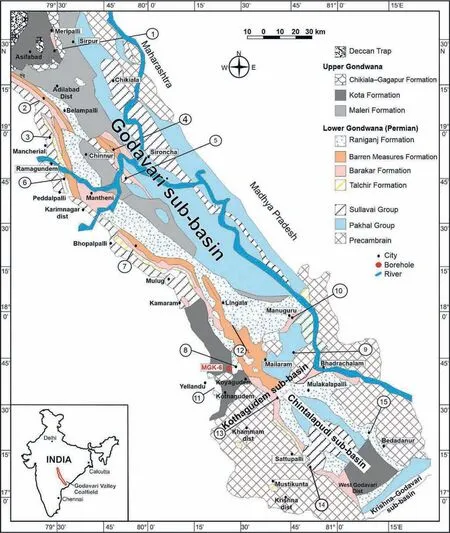
Fig. 1 Location of studied borehole MGK-6 in the Kachinapalli block (Lingala-Koyagudem coalbelt) of the Godavari sub-basin, Godavari Valley Coalfield (location in India is shown in the inset map). Fifteen coalbelts are identified in the Godavari Valley Coalfield. 1:Meripalli-Kagajnagar coalbelt; 2: Dorli-Bellampalli coalbelt; 3: Somagundem-Indaram coalbelt; 4: Chinnur coalbelt; 5:Chandrupalli-Mahadevpur coalbelt; 6: Ramagundam coalbelt; 7: Mulug coalbelt; 8: Lingala-Koyagudem coalbelt (this study); 9: Anisettipalli-Manubothulagudem-Bugga coalbelt; 10: Manuguru Cherla coalbelt; 11: Yellandu coalbelt; 12: Kothagudem coalbelt; 13: South of Kothagudem coalbelt; 14: Ayyanpalem-Yerragunta-Sattupalli-Chintalpudi coalbelt; 15: Gauridevipeta-Bedadnuru coalbelt.
A total of 15 coalbelts have been identified in the Godavari Valley Coalfield, out of which the Lingala-Koyagudem coalbelt is investigated in this study (Fig. 1). This coalbelt lies between the Ramagundam(northwest)active mining centers and Kothagudem (southwest), and occurs the entire Permian(lower Gondwana)succession(Cisuralian-Lopingian).
3.Palynostratigraphy
The palynostratigraphy of borehole MGK-6 was established by Jha and Aggarwal (2015). A list of spore-pollen species along with their botanical affinity, and the percentage of various palynomorphs have been summarized in Table 2 and 3 respectively.Based on the recovered palynoflora, three distinct palynoassemblages(I-III) have been identified.
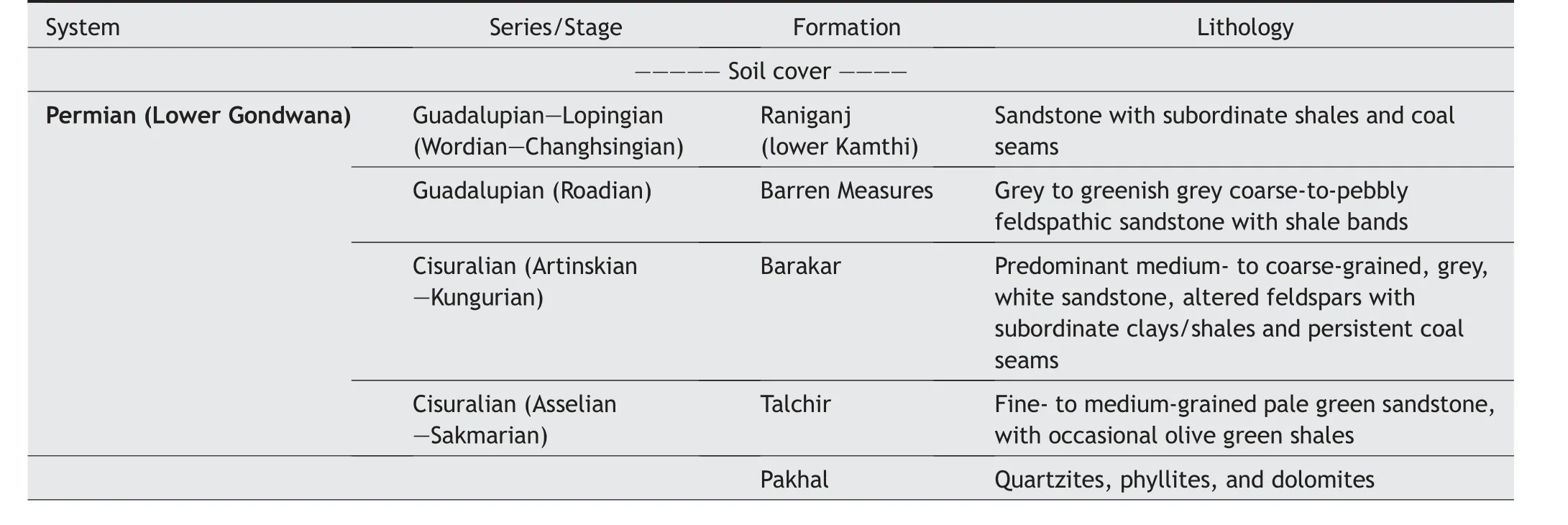
Table 1 Lithostratigraphy in the Kachinapalli block,Godavari sub-basin,southern India(after MECL,2002).
Palynoassemblage I(314.25-346.65 m)is marked by the predominance of non-striate bisaccate pollen Scheuringipollenites tentulus and S. maximus along with a few striate bisaccate pollen, chiefly Faunipollenites bharadwajii, F. varius, and Striatopodocarpites decorus.Palaeovegetation is mainly dominated by arborescent plants (>50%) along with glossopterids,conifers, and cordaites. Rare spores include filicopsids(Lophotriletes rectus, Microbaculispora sp., Brevitriletes communis, and B. unicus). An Artinskian age(Barakar palynoflora) is assigned to this palynoassemblage(Aggarwal and Jha,2013).
Palynoassemblage II (220.70-298 m) exhibits a predominance of striate bisaccate pollen including Faunipollenites bharadwajii, Striatopodocarpites tiwarii, Striatites varius, Lunatisporites diffusus, L.ovatus, Strotersporites indicus and S. communis along with sub-dominant nonstriate bisaccate pollen Scheuringipollenites tentulus, S. maximus, and Ibisporites jhingurdahiensis. The palynofloral content of this palynoassemblage is predominated by conifers (>50%)and sub-dominated by glossopterids. Rare spores include lycopsids (Callumispora sp.), and filicopsids(Brevitriletes unicus, B. communis, Horriditriletesrampurensis, and Verrucosisporites gondwanensis). A Guadalupian age (Raniganj palynoflora) is assigned to this palynoassemblage(Aggarwal and Jha,2013).

Table 2 List of recovered spore-pollen species and their botanical affinity(after Quadros et al.,1996;Die′guez and Barr′o n,2005;Jasper et al., 2006;Beri et al., 2011;Aggarwal et al.,2017)in the borehole MGK-6.
Palynoassemblage III (46.75-206.70 m) shows a predominance of striate bisaccate pollen(Striasulcites ovatus, Striatopodocarpites tiwarii, S. diffusus, Faunipollenites varius, F. parvus, F. bharadwajii, F. goraensis, Crescentipollenites brevis and C. globosus)along with numerous stratigraphically significant taxa such as Corisaccites alutas, Strotersporites indicus,Lunatisporites diffusus, Striomonosaccites circularis,Guttulapollenites hannonicus, Klausipollenites sp.,Falcisporites nuthallensis, F. zapfei, Weylandites circularis, and Chordasporites sp.). A Guadalupian age(Raniganj palynoflora) is assigned to this palynoassemblage(Aggarwal and Jha,2013).

Table 3 Percentage of various palynomorphs at different depths of the borehole MGK-6(after Jha and Aggarwal,2015).
4.Material and methods
4.1. Palynofacies identification
A total of 34 samples from the borehole MGK-6(drilling depth of 490.10 m) were collected from different lithologies such as grey shale, clay, sandstone, carbonaceous shale, and coal (Fig. 2). The samples were prepared for palynofacies study, using the standard non-oxidative procedure followed by Traverse(1994),Tyson(1995),and Prasad et al.(2013).Finally, the residue was mounted in Canada balsam with the help of polyvinylchloride(PVC).The scanning and photography of slides were done with a DP25 Olympus digital camera mounted on a BX62 microscope. More than 300 organic matter particles were examined in each.After calculating the percentage of every category,for every palynofacies,the average of each group was considered. All the prepared slides were studied and are stored at the repository of the Birbal Sahni Institute of Palaeosciences (BSIP), Lucknow, India. Well-preserved various types of organic matter have been shown in Fig. 3.
For the identification of palynofacies, various classifications have been proposed by different researchers (Van Bergen et al., 1990; Lorente and van Bergen, 1991; Batten, 1996; Oboh-Ikuenobe and Yepes, 1997; Oboh-Ikuenobe and de Villers, 2003;Aggarwal et al., 2017). The dispersed organic matter was classified into four major categories (palynomorphs, structured phytoclasts, charcoal/opaque phytoclasts, and biodegraded matter), including further minor categories using the terminology modified by different workers (Van Bergen et al., 1990;Tyson, 1995; Batten, 1996; Oboh-Ikuenobe and Yepes,1997; Oboh-Ikuenobe and de Villiers, 2003; Aggarwal et al., 2019). Various forms of the dispersed organic matter have been summarized in Table 4.
4.2. Total organic carbon and carbon isotope analysis
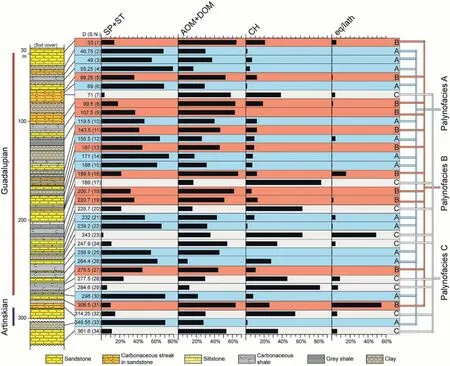
Fig.2 Lithological details and stratigraphic distribution of the three palynofacies,and the percentage of different types of organic matter in each sample (detailed values are shown in Table 5). D (S.N.): Depth (Sample no.); CH: Charcoal/opaque phytoclast; SP: Spore-pollen; ST:Structured phytoclast; AOM: Amorphous organic matter; DOM: Degraded organic matter; eq/lath: Ratio of equidimensional and lath-shaped phytoclasts.
Among 34 samples 17 coal and carbonaceous shale were processed for bulk carbon isotope analysis,using the standard methodology described by Agrawal et al. (2015). Two grams of each sample were weighed and powdered, and repeatedly treated with 5% HCl to remove carbonates. The residue was washed with Milli-Q water in a centrifuge machine(~3000 rpm) to remove acid and soluble salts. The decarbonated samples were dried in a hot air oven with temperature control (~50°C), and then were again powdered with an agate mortar to get fine powder. The samples were weighed and carefully packed into tin capsules which were then introduced into the pre-filled and conditioned reactor of the Elemental Analyzer (Flash EA, 2000 HT) through an autosampler. The CO2gas produced through the combustion was introduced into the Isotope Ratio Mass Spectrometer (IRMS, MAT 253) coupled with the Con-Flow IV interface for isotopic analysis. IAEA (International Atomic Energy Agency) CH3 was used to calibrate the reference gas, and carbon isotopic data have been reported against VPDB (Vienna Pee Dee Belemnite). The international standards (IAEA CH3 and IAEA CH6)and internal standards(sulfanilamide),were run to check the accuracy of CO2measurement with an external precision of±0.1‰.TOC content was calculated from the peak area obtained from the integrated m/z 44,45,and 46 signals(Jensen,1991).All samples were analyzed in the Stable Isotope Laboratory of the Birbal Sahni Institute of Palaeosciences (BSIP), Lucknow, India.
4.3. Biomarker analysis
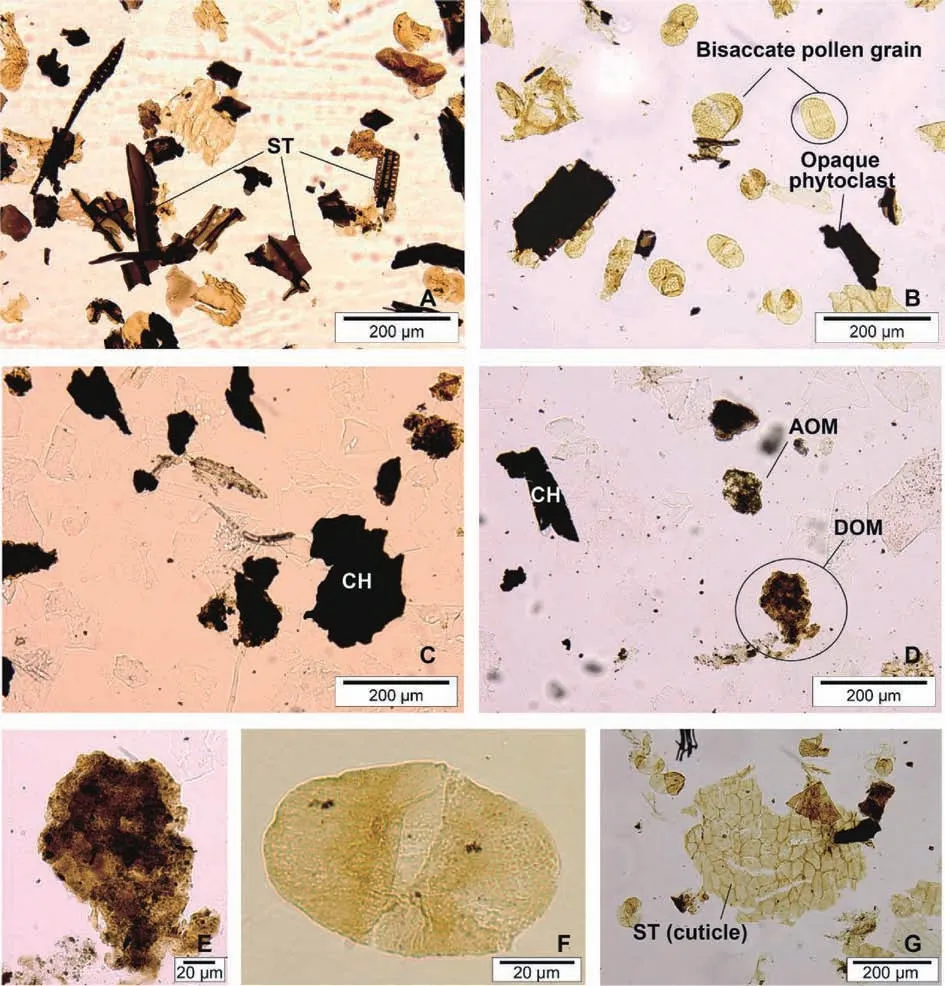
Fig.3 Palynofacies recovered from the borehole MGK-6,based on the various types of dispersed organic matter.A)Palynofacies A dominated by ST (wood remains), BSIP slide no. 13580, H53-1; B) Palynofacies A dominated by bisaccate pollen grains, as well as some opaque phytoclasts,BSIP slide no.14024,L39-2;C)Palynofacies C dominated by CH,BSIP slide no.13575,Q61-3;D)Palynofacies B containing DOM,AOM,and CH, BSIP slide no. 13582, M34-1; E) Enlargement of D (circled), showing the DOM, BSIP slide no., 13582, M34-1; F) Enlargement of bisaccate pollen grain(circled)in B,BSIP slide no.14024,L39-2;G)ST(cuticle),BSIP slide no.14024,Q38-2.CH:Charcoal/opaque phytoclast;ST: Structured phytoclast; AOM: Amorphous organic matter; DOM: Degraded organic matter.
Representative 13 shale samples were selected for biomarker analysis. The soluble organic matter was extracted with dichloromethane and methanol(in 9:1 ratio) which was subsequently fractionated to saturated and aromatic after asphaltene removal. In this study, only the saturated fraction was analyzed.Agilent 7890B gas chromatograph(GC)interfaced with the Agilent 5977A mass spectrometer (MS) fitted with an HP-5MS fused silica capillary column was utilized.Data processing was accomplished by Chemstation software. Peak assignments were based on GC retention time and mass spectral data, including a comparison to MS library and published mass spectra.
5.Results
5.1. Description and distribution of palynofacies
The coal-associated sedimentary facies in the Kachinapalli block of the Godavari sub-basin is described based on quantitative relationships among different types of recovered dispersed organic matter(Figs. 2 and 3). The formation of coal and associated sediments is interrelated with the peat-forming conditions that control the nature of floral content and the preservation of different types of organic matter,which constitute different palynofacies. Three palynofacies have been identified and plotted in a ternary diagram, i.e., palynofacies A (oxic to anoxic forest swamp), palynofacies B (oxic to anoxic lake shores/flooded palaeomires), and palynofacies C (oxidized swamps)(Table 5; Fig. 4).
The ternary diagram suggests that the sediments in Kachinapalli block are largely-dominated by palynofacies A (14 samples) and B (11 samples), formed under oxic to anoxic conditions along with good tissue preservation,while the palynofacies C is represented by nine samples (Table 5, Fig. 4). The ratio ofequidimensional and lath-shaped phytoclasts (eq/lath) was considered to identify the proximal and distal deposition with respect to the sediment source(Table 5).
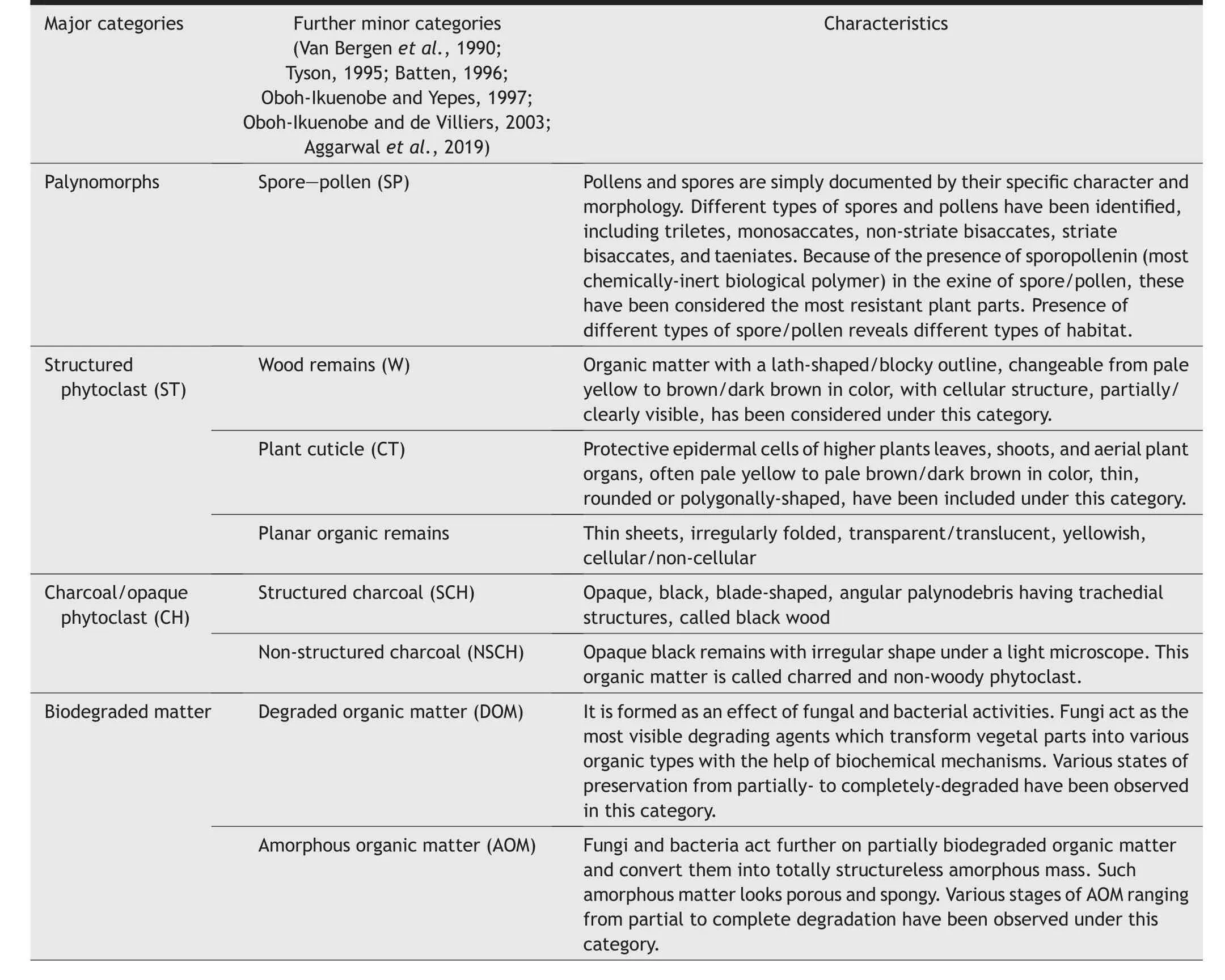
Table 4 Classification of dispersed organic matter(Van Bergen et al.,1990;Lorente and van Bergen, 1991;Tyson,1995;Batten,1996;Oboh-Ikuenobe and Yepes,1997; Oboh-Ikuenobe and de Villers,2003;Aggarwal et al.,2017, 2019).
Palynofacies A is mainly characterized by the predominance of SP and ST (47%-78%, avg. 63.3%), a low percentage of AOM and DOM (10%-47%, avg. 29.8%),and rare CH(1.3%-27%,avg.6.8%),with eq/lath values of 0.3-4(avg.0.99).It contains abundant pollen grains of conifers(22.5%-88%)and glossopterids(12%-59.5%)mainly,along with a few spores(lycopsids,sphenopsids,and filiciopsids) and structured organic matter (wood,tracheids, cuticles, etc.). Its distinctive palynomorphs include Scheuringipollenites tentulus, S. maximus,Striasulcites ovatus, Striatopodocarpites tiwarii, S.diffusus, Faunipollenites varius, F. parvus, F. bharadwajii, F. goraensis, Crescentipollenites brevis, C.globosus, Corisaccites alutas, Strotersporites indicus,Lunatisporites diffusus, Striomonosaccites circularis,Guttulapollenites hannonicus, Klausipollenites sp.,Falcisporites nuthallensis, F. zapfei, and Chordasporites sp. All the pollen grains correspond primarily to gymnospermous pollen grains (striate and non-striate bisaccates). This palynofacies has been documented in the sample numbers 2,3,4,6,10,12,14,15,21,22,25, 26, 30, and 33, which correspond to the fine sediments such as carbonaceous streaks in fine-grained sandstone, carbonaceous shales, grey shales and clay(Fig.2).
Palynofacies B contains abundant AOM and DOM(21%-64%,avg.53.5%),relatively less SP and ST(10%-57% avg. 30.1%), and a moderate amount of CH(0-25%, avg. 18.2%), with eq/lath values ranging 0.2 to 55 (avg. 6.78). This palynofacies has been documented in the sample numbers 1, 5, 8, 9, 11, 13, 16,18,19,27,and 31,which correspond to carbonaceousstreaks in sandstones,carbonaceous shales,siltstones,and coarse-grained sandstone (Fig. 2).
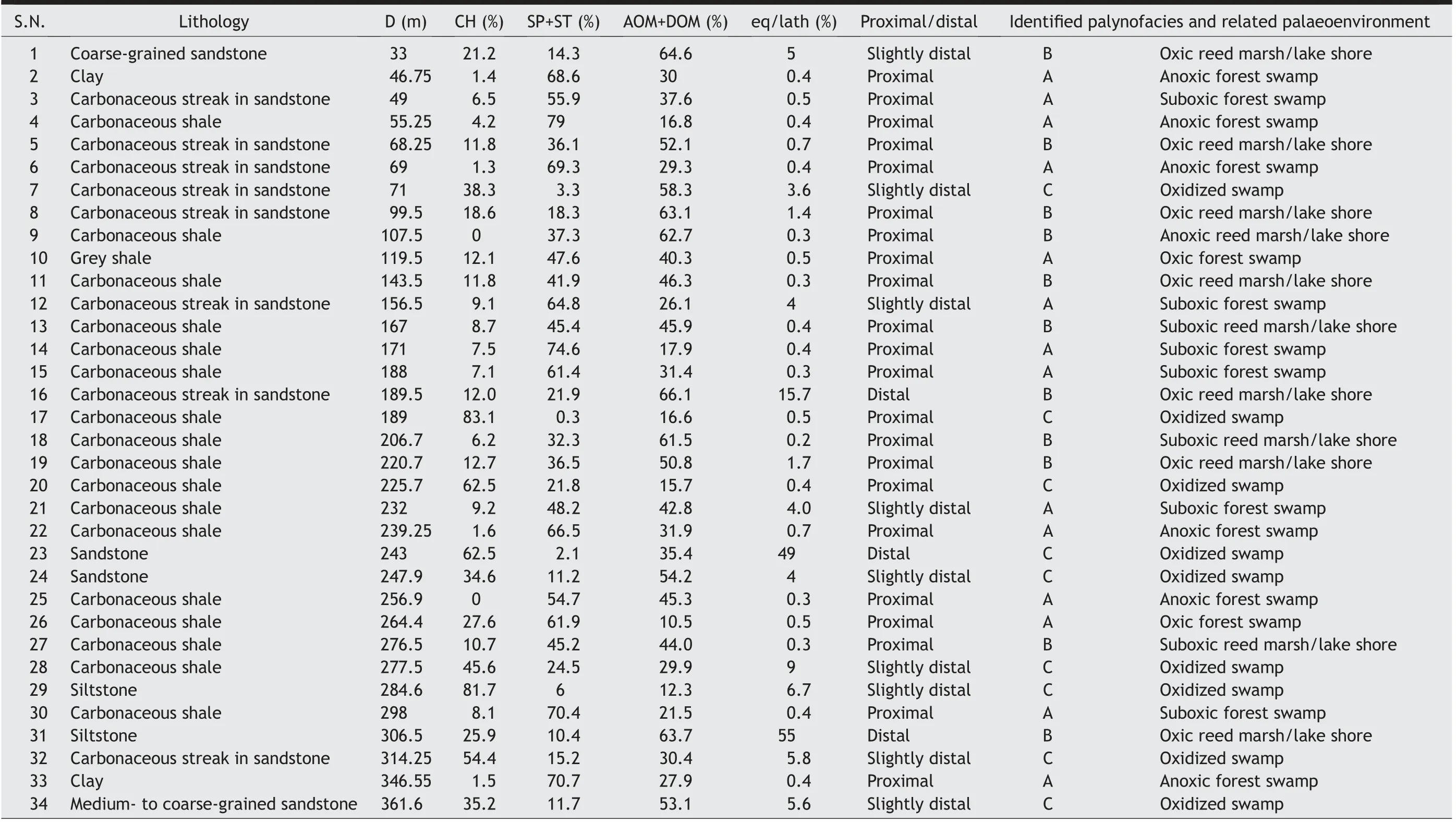
Table 5 Percentage of different types of organic matter in each sample from the borehole MGK-6,and the identifeid palynofacies with its related environment.S.N.:Sample no.;D:Depth;CH:Charcoal/opaque phytoclast;SP:Spore-pollen;ST:Structured phytoclast;AOM:Amorphous organic matter;DOM:Degraded organic matter;eq/lath:Ratio of equidimensional and lathshaped phytoclasts.

Fig.4 A)Ternary diagram showing the quantitative distribution of various palynofacies(modified after Singh and Singh,1996);B)Cross-plot of Pr/Ph and CPI. CH: Charcoal/opaque phytoclast; SP: Spore-pollen; ST: Structured phytoclast; AOM: Amorphous organic matter; DOM:Degraded organic matter; Pr/Ph: Pristane/phytane ratio; CPI: Carbon preference index. Each sample number is labeled in the figure.
Palynofacies C is dominated by CH(34%-83%,avg.55.3%), a smaller proportion of AOM and DOM (12%-58%,avg.33.9%),and relatively rare occurrence of SP and ST (0.3%-24%, avg. 10.7%), with an average eq/lath value of 9.3(ranging 0.3 to 49).This palynofacies has been documented in the sample numbers 7,17,20,23,24,28,29,32,and 34,which largely correspond to sandstones, as well as a few carbonaceous shales and siltstones (Fig. 2).
5.2. δ13C values and TOC content
δ13C ratios of the samples vary from −25.1‰ to−20.9‰ (Table 6; Fig. 5), and show a distinct stratigraphic trend. The lowest δ13C ratio (−25.1‰) occurs at a depth of 361.6 m,in a medium-to coarse-grained sandstone;while the highest ratios(−20.9‰)occurs at a depth of 306.5 m,in a siltstone bed.The δ13C ratios in carbonaceous shales range from −23.7‰to −21.2‰.Overall,the measured δ13C ratio is −25.1‰at 361.6 m deep, followed by a gradual increase up to −20.9‰ at 306.5 m deep (Fig. 5). Subsequently, the values show significant fluctuations from 298 m to 232 m deep,with more negative ratios observed at 298 m(−23.3‰)and 256.9 m (−23.7‰) deep, and less negative values at 264.4 m (−21.4‰) and 232 m (−21.2‰) deep, respectively. Following this, the δ13C ratios remain between−23.2‰ and −22.2‰ for the rest succession(206.7-55.25 m deep)(Fig. 5).
The TOC content of samples ranges from ~0.3% to 53.8%(Table 6).The lowest TOC values were observedin the medium-to coarse-grained sandstone(361.60 m,0.3%) and siltstone (306.50 m, 0.4%), whereas the highest TOC value (53.8%) was found in the carbonaceous shale (239.25 m).

Table 6 δ13C ratios and TOC in the samples from the borehole MGK-6.VPDB:Vienna Pee Dee Belemnite;TOC:Total organic carbon;NA:Not analyzed.

Fig. 5 Depth variations of δ13C values and CPI from the borehole MGK-6.
5.3. Biomarkers
Normal alkanes, isoprenoids, and terpenoid compounds were studied for the present study. These compounds are identified based on the selected mass chromatograms m/z 57, m/z 123, and m/z 191, and their distributions in the studied samples are provided in Fig. 6. The n-alkane hydrocarbon fractions are dominated by the homologous series ranging from C15to C31. Both unimodal and bimodal distribution patterns are evident in these samples. The carbon preference index(CPI) values are calculated for the given set of samples, and range from 0.46 to 2.25. The various biomarker compounds identified in the samples are given in Table 7. Terpenoids identified include sesquiterpenes, diterpenes, and triterpenes. C15-bicyclic sesquiterpene, C15β(H)-drimane, and 8β(H)-homodrimane are the identified sesquiterpenoids.Diterpenoids found in the extracts include C18-diterpene, 8α(H)-labdane, ent-beyerane, and phyllocladanes.Tricyclic terpanes identified include C19and C23hydrocarbons. The samples are characterized by the high relative abundance of hopane type of pentacyclic triterpenoids. Tetracyclic 17, 21-secohopanes(C24) are also present in these samples.
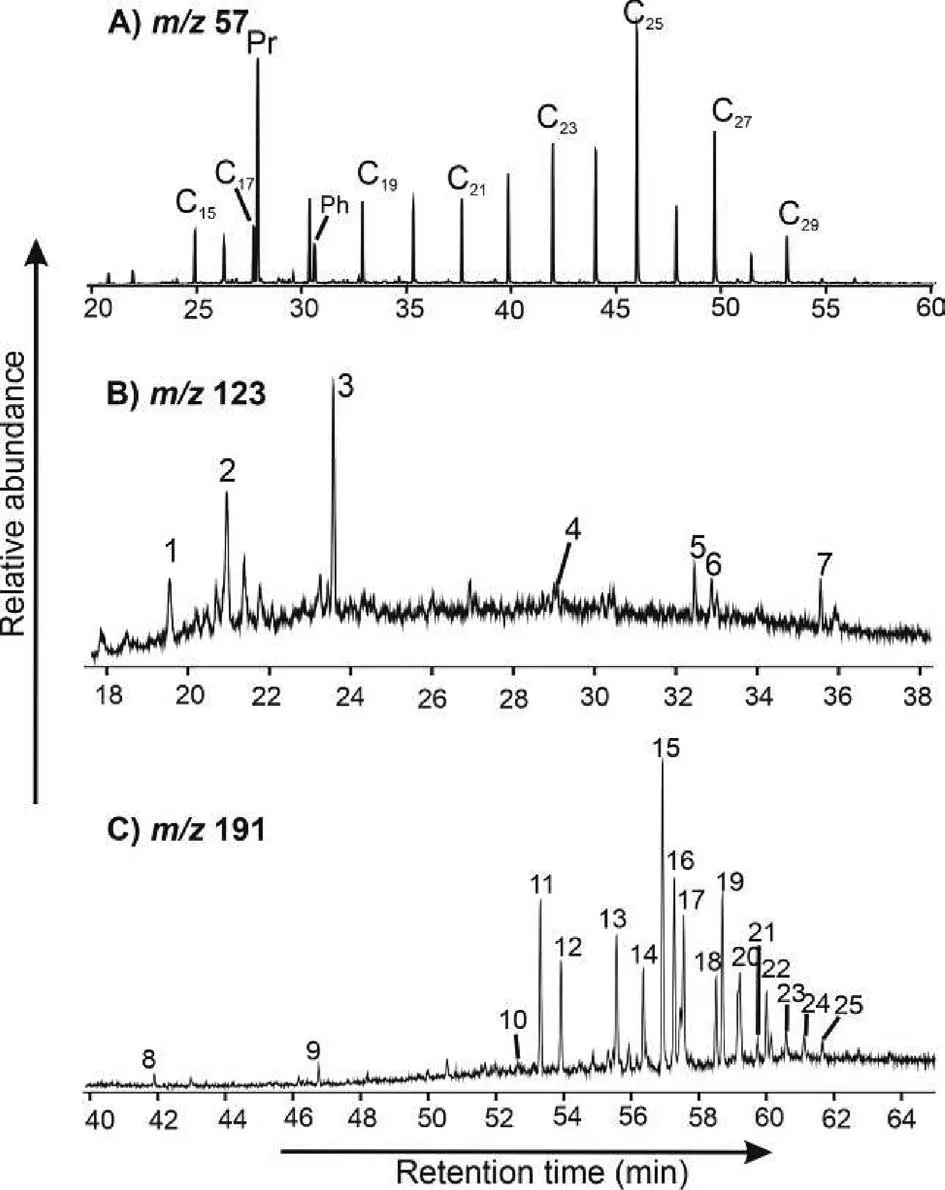
Fig.6 Representative mass chromatograms A)m/z 57,B)m/z 123,and C) m/z 191, showing biomarker compounds. The peaks are numbered from 1 to 25, with their identified compounds shown in Table 7.
6.Discussion
6.1. Palynofacies
Palynofacies A is characterized by abundant bisaccate pollen grains(striate and nonstriate),few spores,and terrestrially-derived structured organic matter,mainly woody material. The most prominent lignified structures in the palynological slides were xylem elements, including tracheids and vessels. The lignified wood used to be primarily prevalent in palynodebris from marine/non-marine provinces, but they are strongly dependent on the proximity of the resource(Tyson, 1995). Glossopterids and conifers are dominated by bisaccate pollen grains. Glossopterids represent hygrophilous to mesophilous environmental conditions (Martín-Closas et al., 2005), while conifers flourished in upland conditions with a temperate climate(Falcon,1975,1989;G¨otz and Ruckwied,2014;Ruckwied et al., 2014). Coniferous plants used to be transported from far-away areas to the palaeomires(Knoll and Niklas, 1987). The predominance of bisaccate pollen grains and structured organic matter(wood particles, tracheids, cuticles, etc.) in fine-grainedsediments (carbonaceous streaks in sandstone, carbonaceous shales,grey shales,and clay),points to either a marine or lacustrine origin in low-energy settings(Rousseau et al.,2006;Steemans et al.,2009;Ruckwied et al., 2014). Tree-dominated palaeovegetation(including ferns, cycads, and larger glossopterid trees)is more typical for broad swamps (Wheeler and G¨otz,2017). Consequently, development of the palynofacies A has been attributed to proximal low-energy environments (eq/lath: 0.3-4, avg. 0.99). This palynofacies corresponds with a high clay, grey shale, and carbonaceous shale content along with minor alternating layers of sandstone lithologies (Fig. 2). The sediment association demonstrates a slow-moving to stagnant water setting, but due to high evapotranspiration and warm climate during the deposition of Barakar and Raniganj formations, the water level must have been reduced,which led us to interpret this palynofacies as a forest swamp. Most of the samples of this palynofacies are represented by anoxic and suboxic conditions(Table 5),which further support stagnant water conditions.As no marine signature (pyritic sandstone, Balmeela, Tetraporinia,Leiosphaeridia,foraminiferal linings,etc.)has been documented in this succession,it can be assumed that palynofacies A represents freshwater forest swamps in proximal settings (Fig. 7). The concurrence of sediment and organic matter components has led us to infer a moderate water level during the deposition of palynofacies A.
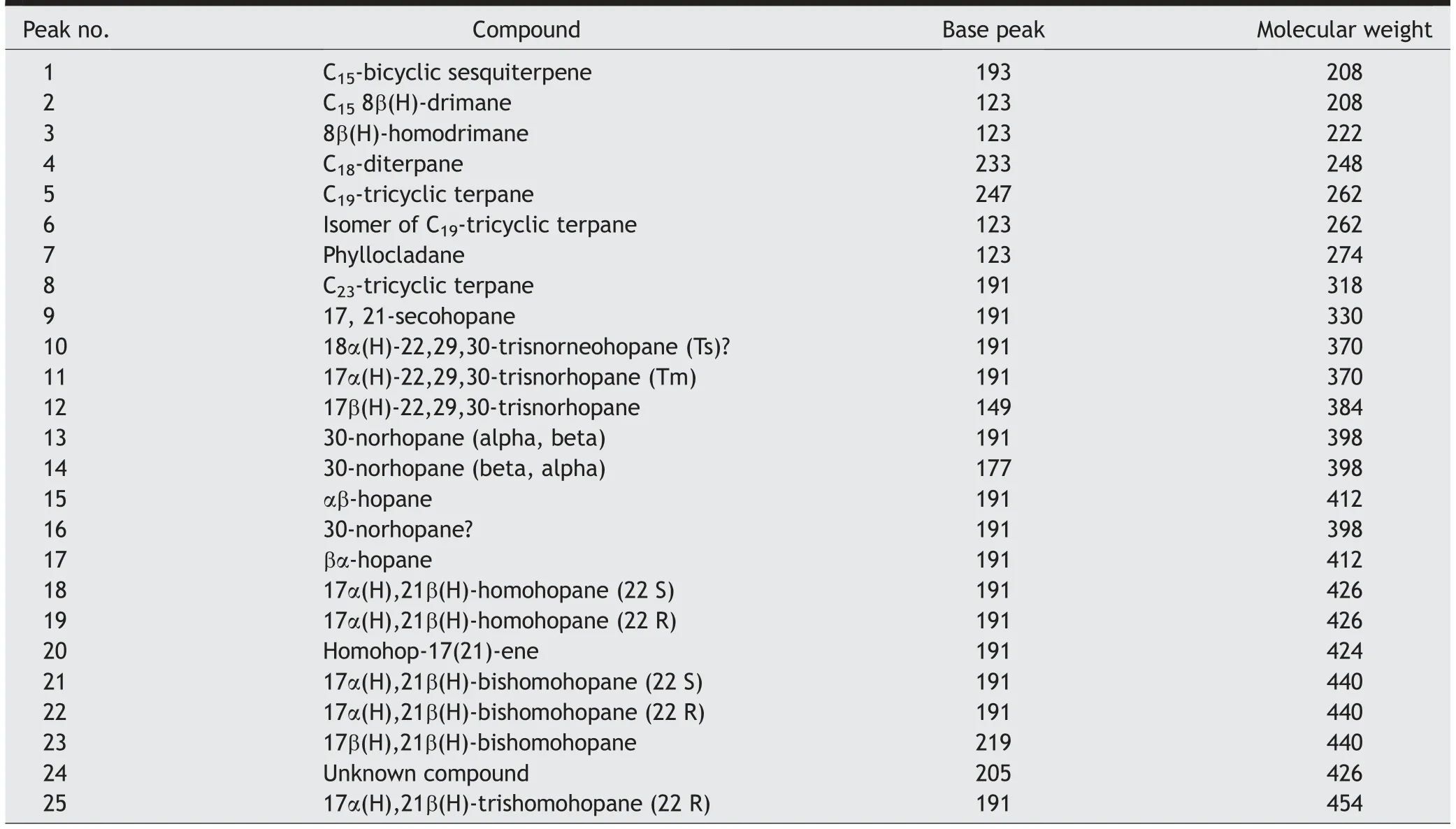
Table 7 Biomarker compounds identified in the studied samples.The peak numbers are corresponding to the ones marked in Fig.6.
Palynofacies B is recognized by abundant DOM and AOM, a relatively-lower content of SP and ST, along with moderate amounts of CH.The DOM is a product of microbial degradation (fungal/bacterial) of phytoclasts (woody material, cuticles, plant tissues, etc.)under slight flow water settings (Tyson, 1993, 1995;Peters et al., 2013); while the AOM is a product of living or dead microbial degradation(fungal/bacterial)of partially-degraded structured organic matter(wood,cuticles,plant tissues,etc.)(Tyson,1995).The preservation of DOM and AOM is highly dependent on chemical and physical degradation, but the most important parameter is oxygen content. Previous researchers (Vald′es et al., 2009) illustrated that darkcoloured AOM represents the dysoxic/anoxic water bottom conditions while light-coloured AOM is representative of oxic conditions.Later,Pacton et al.(2011)demonstrated that anoxia promotes a progressive darkening due to polymerization.The average eq/lath value is 6.78 (ranging 0.2 to 55). This palynofacies occurs in siltstones, sandstones, and frequent intercalations of carbonaceous shales (Fig. 2). The composition may be the result of elevated water levels in the environment with prominently stagnant conditions. Alternating cycles of coarse-grained to finegrained sediments can be easily identified, which demonstrates the highly cyclic changes in water current allocating differential settling of the coarse and fine sediment,respectively.The high water content in this palynofacies can also be supported by the high percentage of spores (lycopsids, sphenopsids, and filiciopsids) at the depths of 220.7 m, 206.7 m, and 107.5 m (Fig. 2). DOM and AOM preservation are promoted in stagnant oxygen-depleted water (Powell et al., 1990), foreswamp settings (Traverse, 1994),and flooded palaeomires (Zhang et al., 2010). The concurrence of sediment and organic matter components has led us to infer a high water level during the deposition of palynofacies B.Resultantly,palynofacies B most likely represents lakeshore/flooded palaeomires in slightly distal settings (Fig. 7).
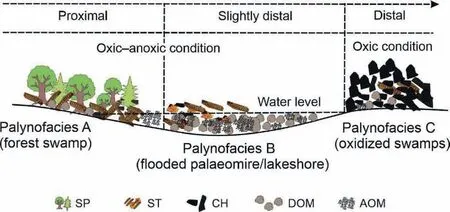
Fig. 7 A conceptual depositional model for the Kachinapalli block of the Godavari sub-basin based on palynofacies. CH: Charcoal/opaque phytoclast; SP: Spore-pollen; ST: Structured phytoclast; AOM: Amorphous organic matter; DOM: Degraded organic matter.
Palynofacies C is characterized by the dominance of CH (34%-83%, avg. 55.31%), moderate amounts of DOM and AOM (12%-58%, avg. 33.91%), along with a scarce presence of SP and ST(0.3%-24%,avg.10.68%).CH was formed as a result of partially-oxygenated to oxygenated environmental conditions of woody material (Martín-Closas et al., 2005; Cincotta et al.,2015) at normal or elevated temperatures. Charcoal appears mostly as highly corroded homogeneous opaque fragments (elongated/sharp), which often break into smaller opaque particles during transportation.These are the most common elements of lacustrine and stream deposits. The presence of these particles has also been documented in oxic swamps, prodelta,delta fronts, fluvial sediments, etc (Masran and Pocock, 1981; Pocock et al., 1987; Martín-Closas et al., 2005; Pie~nkowski and Waksmundzka, 2009).The dominant occurrence of charcoal along with other organic matter in the samples represents flooding actions in oxygenated conditions (Tyson, 1989; Cincotta et al., 2015). Palynofacies C has been retrieved mainly from sandstone/carbonaceous streaks in sandstone/minor intercalations of carbonaceous shales.This might be due to the abundant supply of terrigenous clastic sediments during high precipitation. The concurrence of deposits and organic matter components has led us to infer an oxidizing/high-energy environment during the deposition of palynofacies C.High eq/lath values (avg. 9.3, ranging 0.3-49), along with oxidizing conditions, infer distal oxidized swamp settings for this palynofacies (Fig. 7).
6.2. Isotope
The bulk δ13C ratios from borehole MGK-6 are consistent with earlier records from the Sattupalli coalfield of the Godavari Valley Coalfield(de Wit et al.,2002; Singh et al., 2012) and the studies from other Permian age terrestrial Gondwana basins (Wu et al.,2019 and references therein). The most negative bulk δ13C ratio of −25.1‰ in the borehole MGK-6 is recorded from medium-to coarse-grained sandstone,which might have undergone prolonged diagenesis due to high porosity and permeability and may not reflect the primary organic composition. Therefore, this δ13C ratio (−25.1‰) has not been considered for the discussion. These bulk δ13C values (−23.7‰ to −20.9‰)indicate that the organic matter accumulated in carbonaceous shale, sandstone, and clay was derived from higher C3plants.Furthermore,bulk organic δ13C ratios show a statistically significant (Pearson correlation coefficient (P) < 0.05) positive correlation with eq/lath(R=0.57)and CH/(SP+ST)(R=0.52)(Table 8).This relationship demonstrates an intricate control of the palynofacies on the bulk organic carbon isotopic composition. This link between the palynofacies and the bulk organic carbon isotope values might indirectly represent of their co-dependency on the climatic parameters such as precipitation, temperature, and the depositional environment, i.e., redox conditions etc.An increase in equidimensional and charcoal forms represents an increase in the bulk organic δ13C ratios.As equidimensional and charcoal forms represent distant deposition and more oxidizing conditions, one alternative explanation for the associated increase in the bulk organic δ13C could be reworking/oxidation of the original organic composition.On the contrary,the increase in the SP+ST and the lath-shaped phytoclasts represent a proximal deposition, representing a decrease in the bulk organic δ13C values.Similarly,the decrease in bulk organic δ13C ratios can be explained by relatively less oxidation/reworking of the original organic matter. Although a quantitative estimation of diagenetic alteration in the bulk organic δ13C values of rock records is currently not possible, lab-based incubation experiments demonstrated that these changes generally cause less than 1‰ shift, often a decrease from the original value (Freudenthal et al., 2001;Lehman et al., 2003).

Table 8 Correlation matrix(R values)among the palynofacies parameters(CH,SP+ST,AOM+DOM,eq/lath)and δ13C.
The bulk organic δ13C range(−23.7‰to −20.9‰)and the average organic δ13C ratios(−22.6 ±0.98‰) in this study match well with the pre-CIE (carbon isotope excursion around Permian-Triassic boundary)values of the global chemostratigraphy reported by Wu et al.(2019). The bulk organic δ13C ratios in the borehole record show an overall stratigraphic shift (change between the maximum and minimum δ13C ratios)of 2.8‰,which is significantly large and might not be explained only by diagenetic alterations. Alternatively, these shifts in the bulk organic δ13C ratios could be explained by changes in palaeovegetation patterns in response to varying mean annual precipitation (MAP) or change in pCO2, i.e., increase in pCO2or reduced precipitation generally lead to a decrease in isotopic fractionation or less negative bulk organic δ13C values and vice-versa(Diefendorf et al., 2010; Kohn, 2010; Schubert and Jahren, 2018). However, there is no record of a global increase in pCO2for the pre-CIE period,suggesting that local changes in MAP most likely influenced the bulk organic δ13C values.Therefore,the decrease in the bulk organic δ13C ratios and increase in the abundance of SP+ST and lath-shaped phytoclasts in the sedimentary record might be related to an increase in MAP.Whereas the increase in the bulk organic δ13C values and increase in the abundance of equidimensional phytoclasts and charcoal palynofacies was perhaps related to a decrease in MAP.
6.3. Biomarkers
The short-chain alkanes point to microbial sources(Cranwell, 1977); medium-chain alkanes suggest input of aquatic organic matter (Ficken et al., 2000, 2002);while long-chains are indicators of terrestrial higher plant input (Eglinton and Hamilton, 1967). Carbon preference index (CPI) values equal to 1 suggest an insignificant higher plant source (Killops and Killops,2005), while values greater than 1 indicate significantly higher plant input (Moldowan et al., 1985). Significant variations in CPI values are observed in this study (Table 9, Fig. 5), suggesting drastic temporal changes in the source of the organic matter, further elucidating changes in the ecological and climaticconditions. Some low CPI values identified may be due to the maturity of these samples, since immature terrigenous organic matter is observed to have CPI values ≥5 (Bechtel et al., 2012). However, CPI values are observed to decline according to the rank of the organic matter due to thermal cracking and simultaneous generation of even carbon numbered n-alkanes by the reduction of n-fatty acids and alcohols (Radke et al., 1980; Littke and Leythaeuser, 1993; Killops et al.,2001).

Table 9 Alkane parameters according to the palynofacies from the studied samples of borehole MGK-6.CPI(carbon preference index):2(C23+C25+C27+C29)/(C22+2(C24+C26+C28)+C30)(Peters and Moldowan,1993);TAR(Terrigenous/Aquatic Ratio):(C27+C29+C31)/(C15+C17+C19)(Bourbonniere and Meyers,1996); Pwax (Proxy wax): (C27+C29+C31)/(C23+C25+ C27+C29+C31)(Zheng et al., 2007);Paq (Proxy aqueous):(C23+C25)/(C23+C25+C29+C31)(Ficken et al.,2000).
Pentacyclic triterpenoid hopanes are assumed to be formed during the bacterial degradation of organic matter under aerobic conditions. However, anaerobic bacteria are considered as the precursor of hop-17(21)-ene(Wolff et al.,1992).It is generally considered that bacteriohopantetrol and, to a smaller extent, 3-desoxyhopanes are the biological precursors of hopane derivatives (Ourisson et al., 1979; Rohmer et al., 1992). The homohopanes present in the samples are found to be formed from bacteriopolyhopanol,a compound present in the prokaryotic cell membrane(Roushdy et al.,2010).Tetracyclic 17,21-secohopanes identified in the samples are believed to be originated during the thermal or microbial degradation of hopane precursors (Peters et al., 2005). Diterpenoids are the indicators of conifer plants in which they are part of essential oils and resinous substances. In the extant gymnosperms,compounds with phyllocladane skeleton are characteristic of Podocarpaceae, Phyllocladaceae,Taxodiaceae,Araucariaceae,and Cupressaceae(Noble et al., 1985; Otto and Wilde, 2001). ent-Beyerane is also reported from these families. However, in Pinaceae, these compounds are absent (Otto and Wilde,2001). Altogether, the presence of these compounds,along with the palynological evidence, suggests significant primitive conifer forest vegetation in the hinterland.
The analysis of n-alkanes corroborates well with the palynofacies data. The biomarker study has been performed on thirteen samples, out of which, five,four, and four samples fall in the three palynofacies assemblages (Table 9), respectively.
6.3.1. Palynofacies A
The palynofacies characteristics are compared with the alkane data.The studied samples belonging to palynofacies A are 4,22,25,30,and 33.The n-alkane data generally shows a high pristane/phytane ratio(Pr/Ph: 0.53-6.14) and terrigenous/aquatic ratio(TAR: 0.34-1.59). This TAR suggests dominantly terrestrial conditions, but with both terrestrial and aquatic inputs(Table 9).The carbon preference index(CPI) is generally high(>1), indicating increased input from coaly/higher plant source materials during the formation of this palynofacies. The aquatic macrophyte input was also high,as indicated by the high Paq(proxy aqueous) values (>0.7). These parameters generally indicate a dominantly terrestrial condition as indicated by the palynofacies A (Fig. 7).
6.3.2. Palynofacies B
The studied samples belonging to this palynofacies are 5, 9, 19, and 31. This palynofacies is characterized by moderate CPI (0.68-2.25), suggesting relatively low higher plant input except for the samples 9 and 19. The generally low values of Pr/Ph, TAR(<0.85), and waxiness (Pwax: <0.18) suggest a relatively lower input of terrestrial vegetation compared to palynofacies A (Table 9). The aquatic macrophyte input was similarly high as in palynofacies A. The parameters indicate a general decrease in the input of terrigenous organic matter, which is comparable with palynofacies B (Fig. 7).
6.3.3. Palynofacies C
The studied samples belonging to this palynofacies are 20,28,32 and 34.In this facie,most of the samples show a relatively low Pr/Ph value except for the sample 20. The relatively low CPI and TAR values suggest generally low higher plant input (Table 9).
6.4. Palaeodepositional settings
Based on the interpretation of palynofacies, the Kachinapalli block mainly represents oxic conditions with comparatively few anoxic events during the deposition of Permian (lower Gondwana) (Table 5). In the described palynofacies model (Fig. 7), the Kachinapalli block shows its origin in swampy forest condition with good tissue preservation supporting the interpretations drawn from carbon isotope and biomarker studies. The molecular proxy, i.e., concentration and distribution of n-alkanes in the prepared samples, shows the dominance of long-chain alkanes(C27,C29)with high CPI values,which indicate land plants as the source of organic matter. The δ13C values (−23.7‰ to −20.9‰) also support this view and suggest that the organic matter which accumulated in carbonaceous shales, sandstones, and clay are terrestrial in origin and originated from higher C3plants.The complete succession of borehole MGK-6 is influenced by oxygenated conditions except at some places(Fig. 2), suggesting that the sequence was characterized by warm and humid climate conditions in the hinterland with smaller variations at different levels as revealed by palynofacies(Fig.2),carbon isotope,and biomarker studies.
At a core depth of 361.6 m (sample 34), the palynofacies indicates oxic conditions due to the dominance of CH, which corroborates with the lowest TOC content. Following this, at a core depth of 346.55 m(sample 33), the palynofacies indicate anoxic forest swamp settings (Table 5), which is directly supported by high TOC content, and low δ13C value(δ13C = −23.1‰). Sample 31 (core depth of 306.5 m)represents oxic conditions, directly corroborated by the very low TOC content and a higher δ13C value.
In contrast, the core depths of 33-298 m are characterized by a predominance of oxic conditions,while anoxic conditions prevailed only at some core depths (256.9 m, 239.25 m, 107.5 m, 69 m, 55.25 m,and 46.75 m). This is also supported by the TOC content, which also shows lower values during oxic conditions and vice versa.The stable carbon isotope data show more or less constant values(−23.7‰to −20.9‰),which further indicate dominance of oxygenated conditions throughout the succession of borehole MGK-6.Overall the palynofacies, TOC content, δ13C, and biomarker studies suggest the terrestrial to aquatic transition of the depositional environment (Fig. 4).
7.Conclusions
Based on the multiproxy data set for the Permian sediments (borehole MGK-6) of the Godavari subbasin, southern India, the following inferences can be drawn:
1) Three distinct palynofacies (A-C) have been identified.Palynofacies A(dominated by the abundance of arborescent vegetation and structured organic matter) represents freshwater forest swamps in a proximal depositional setting. Palynofacies B(characterized by an abundance of DOM and AOM)represents lakeshore/flooded palaeomires in a slightly distal setting. Finally, palynofacies C(dominated by CH) represents a distal setting with high transportation and enhanced runoff. These palynofacies change unanimously, even with slight variability of the hydrodynamic conditions. The minor fluctuations observed in the palynofacies helps in identifying the subtle environments of deposition in the present study.
2) The bulk organic δ13C ratios in the borehole record show a stratigraphic change of 2.8‰, which along with the organic matter reworking, could be linked to a change in palaeovegetation patterns in response to changes in mean annual precipitation (MAP) or high seasonality.A decrease in the bulk organic δ13C ratios and an increase in the abundance of SP+STand lath-shaped phytoclasts in the sedimentary record were perhaps related to an increased MAP.Whereas the increase in the bulk organic δ13C ratios and increase in the abundance of equidimensionalphytoclasts and charcoal palynofacies represented a decrease in MAP in palynofacies C.
3) It is suggested that the coal/carbonaceous shale was formed under fluctuating oxic and anoxic conditions,which can be correlated to a fluctuating water table in the basin. Overall, biomarker composition (presence of hopanes in most of the samples,suggesting significant bacterial degradation of organic matter during the deposition), TOC content, and carbon isotopes in the Permian succession also suggest the presence of microbially-altered organic matter as well as vascular plant input. The CPI, TOC content,and carbon isotope data also support predominating oxic conditions punctuated by pulses of anoxic conditions inferred through palynofacies in the Kachinapalli palaeomire.
Abbreviations
AOMAmorphous organic matter
avg.Average
BSIPBirbal Sahni Institute of Palaeosciences
CHCharcoal/opaque phytoclast
CIECarbon isotope excursion
CPICarbon preference index
CTPlant cuticle
DOMDegraded organic matter
eq/lath Ratio of equidimensional and lath-shaped phytoclasts
GCGas chromatograph
IAEAInternational Atomic Energy Agency
IRMSIsotope ratio mass spectrometer
MAPMean annual precipitation
MECL Mineral Exploration Corporation Limited
MSMass spectrometer
NSCH Non-structured charcoal
PPearson correlation coefficient
PaqProxy aqueous
Pr/Ph Pristane/phytane ratio
PTPlant tissues
PVCPolyvinylchloride
PwaxProxy wax
SCCL Singrani Collieries Company Limited
SCHStructured charcoal
SPSpore-pollen
STStructured phytoclast
TARTerrigenous/aquatic ratio
TOCTotal organic carbon
VPDB Vienna Pee Dee Belemnite
WWood remains
δ13CCarbon isotope
Availability of data and materials
The data and material are available in the Birbal Sahni Institute of Palaeosciences (BSIP), Department of Science and Technology (DST), Lucknow, India.
Authors' contributions
NA conducted the sample collection, generated and interpreted the data of palynology and palynofacies, and processed biomarker and isotopic studies; RPM generated and interpreted the data of biomarker; AHA interpreted isotopic data and its tagging with palynofacies; BT integrated palynofacies and biomarker;SA generated isotopic data.All authors read and approved the final manuscript.
Funding
This study was funded by the Birbal Sahni Institute of Palaeosciences, Department of Science and Technology,Lucknow,India(BSIP/RDCC/Publication no.63).
Conflicts of interest
The authors declare that they have no competing interests.
Acknowledgements
The authors convey their sincere thanks to the Director, Birbal Sahni Institute of Palaeosciences, Lucknow, India, for the permission to publish the results(BSIP/RDCC/Publication no.63).NA is also thankful to Singareni Collieries Company Limited (SCCL) and Mineral Exploration Corporation Limited (MECL) for permission to collect the samples. Special thanks to SMB Chari, former CGM, SCCL for providing the field assistance.Authors also express their sincere gratitude to anonymous reviewers,for their valuable suggestions which improve the manuscript quality.
 Journal of Palaeogeography2022年1期
Journal of Palaeogeography2022年1期
- Journal of Palaeogeography的其它文章
- Giant ooids of microbial origin from the Zhangxia Formation (Cambrian Miaolingian Series) in North China
- Bioturbation enhanced petrophysical properties in the Ordovician carbonate reservoir of the Tahe oilfield, Tarim Basin, NW China
- Book Review on River Planet:Rivers from Deep Time to the Modern Crisis by Martin Gibling
- Lagoonal carbonate deposition preceding rifting-related uplift: evidence from the Bartonian-Priabonian (Eocene) of the northwestern Gulf of Suez (Egypt)
- Middle Jurassic climate oscillations from paleosol records of the Sichuan Basin,SW China
- Silurian ostracods from the Nyalam region,southern Tibet,China and their implications on palaeoenvironment and palaeobiogeography
